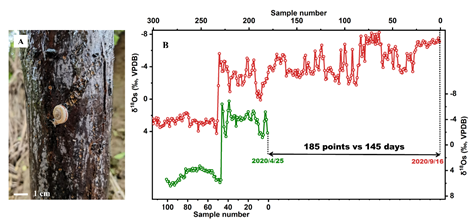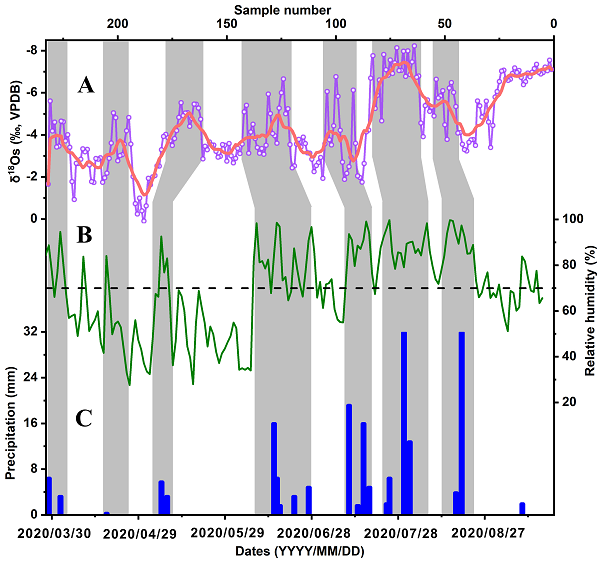Extreme weather events (e.g., rainstorm, typhoon), which have profound societal, economic and environmental impacts, are the hotspots of climate change studies. However, short instrumental data limits our understanding of their mechanism and the evaluation of climate models. Thus far, it is still difficult to project the future trend of extreme weather events in the newly released IPCC report. The time resolution in traditional paleoclimate studies is usually on month or even longer time, which makes it impossible to reveal extreme weather events happened at daily to hourly scale. Therefore, it will be valuable to extract paleoweather signals in geological archives.
The research group from Institute of Earth Environment, Chinese Academy of Sciences (IEECAS), have been committed in the explorations on paleoweather studies. Their recent studies have established several daily-hourly resolution proxies from the marine giant clam shells of Tridacna species using Confocal laser scanning microscope (CLSM) and nano scale secondary ion mass spectroscopy (NanoSMIS), and they successfully reconstructed the extreme weather events, such as typhoon, cold wave, Madden-Julian Oscillation(MJO) etc., in northern South China Sea. Therefore, they pioneered the new research field of Paleoweather.
Recently, to further apply this techniques to terrestrial environment, they explored the potential of using land snail shells for extreme weather reconstruction, and they established a daily-weekly resolution land snail shell oxygen isotope (δ18Os) sequence using SIMS 1280 HR, which could well reconstruct weather scale precipitation events in study region.
The Cathaica Fasciola (Draparnaud, 1801) snails are readily available in IEECAS and are selected for ultra-high resolution (~30 micron) δ18Os analysis, and each δ18Os data point corresponds to one day based on this study. Meanwhile, the precipitation amount and its oxygen isotope compositions were monitored in the campus of IEECAS since 2019. Notably, it showed that the variations of the ultra-high resolution δ18Os sequence resemble the monitored changes in precipitation (i.e., amount and oxygen isotope), and both oxygen isotope records show a negative trend from April 2020 to September 2020. Moreover, the six negative excursions in δ18Os matched well with six time periods of increased precipitation in detail. Furthermore, there is a strong correlation between the oxygen isotope data of precipitation and snail shell for the six events, suggesting the potential for quantitative reconstruction of precipitation amount using the negative δ18Os data. These evidences demonstrate that land snail shells are valuable and promising ultra-high-resolution archives for characterizing terrestrial paleoweather, such as extreme precipitation events.
Considering the widely distributed and well-preserved fossil snails in the loess-paleosol sequences on the Chinese Loess Plateau, they are of great potential in paleo extreme precipitation event reconstructions in the geological past, and the current study laid good foundation for this aim. Thus far, the research group have collected large amount of fossils from various climatic background, and the related paleoweather studies are still on going.
Current study is published in Geochimica et Cosmochimica Acta.

Fig 1. (A) The photo of Cathaica fasciola. (B) The ultra-high resolution δ18O profiles obtained by SIMS.
The two land snail specimens were collected on 2020/4/25 and 2020/9/16, respectively, and they share similar δ18O variations before 2020/4/25, suggesting good repeatability of the δ18O data. The abrupt negative δ18O shift indicates the break of dormancy of snails. 185 δ18O data were obtained from the shell formed in 145 days from 2020/4/25 to 2020/9/16, corresponding to the average resolution of ~ 0.78 days per each δ18O data.

Fig 2. Comparison of the daily resolution δ18O profile with the instrumental precipitation and relative humidity data. Almost each large negative shift in δ18O corresponds to a precipitation event.
(A) The ultra-high resolution δ18O data (purple dotted line) and the smoothed result (solid pink line); (B) Instrumental relative humidity (solid green line). The black dotted line shows the potential relative humidity threshold (70%) at which the snail become active. (C) The instrumental precipitation (blue bars).
This study was conducted by researchers from Institute of Earth Environment, Chinese Academy of Sciences (IEECAS), Xi’an Institute for Innovative Earth Environment Research, and Guangzhou Institute of Geochemistry, Chinese Academy of Sciences. Dr. Jibao Dong is the first author from IEECAS, who studies on land snail and paleoclimate, and his recent work are published in Geochimica et Cosmochimica Acta, Chemical geology, Palaeogeography, Palaeoclimatology, Palaeoecology, etc.. Dr. Hong Yan is the corresponding author, who is also the director of paleoweather research group in IEECAS and His group first proposed the concept and study field of Paleoweather.
Contact: Bai Jie, Institute of Earth Environment, Chinese Academy of Sciences, Xi'an, China. Email: baijie@ieecas.cn